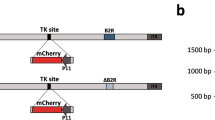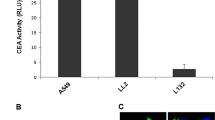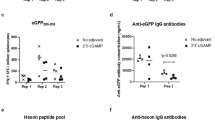Abstract
The cytomegalovirus (CMV) promoter is considered to be one of the strongest promoters for driving the in vivo expression of genes encoded by DNA vaccines. However, the efficacy of DNA vaccines has so far been disappointing (particularly in humans), and this might be explained in part by histone deacetylase (HDAC)-mediated chromatin condensation. Hence, we sought to investigate whether increasing the expression of DNA vaccine antigens with the HDAC inhibitor OSU-HDAC42 would enhance the efficacy of DNA vaccines in vivo. A luciferase assay was used to determine the effects of OSU-HDAC42 on CMV promoter-driven DNA plasmids in vitro and in vivo. Three HDAC inhibitors were able to activate expression from the CMV promoter in NIH3T3 cells and MBT-2 bladder cancer cells. The expression of luciferase was significantly enhanced by co-administration of pCMV-luciferase and OSU-HDAC42 in mice. To explore whether OSU-HDAC42 could enhance the specific antitumor activity of a neu DNA vaccine driven by the CMV promoter, we evaluated therapeutic effects and immune responses in a mouse tumor natively overexpressing HER2/neu. Mice receiving OSU-HDAC42 in combination with the CMV-promoter neu DNA vaccine exhibited stronger antitumor effects than mice given the DNA vaccine only. In addition, a correlation between the antitumor effects and the specific cellular immune responses was observed in the mice receiving the DNA vaccine and OSU-HDAC42.
This is a preview of subscription content, access via your institution
Access options
Subscribe to this journal
Receive 12 print issues and online access
$259.00 per year
only $21.58 per issue
Buy this article
- Purchase on Springer Link
- Instant access to full article PDF
Prices may be subject to local taxes which are calculated during checkout






Similar content being viewed by others
References
Lowe DB, Shearer MH, Kennedy RC . DNA vaccines: successes and limitations in cancer and infectious disease. J Cell Biochem 2006; 98: 235–242.
Cui Z . DNA vaccine. Adv Genet 2005; 54: 257–289. Review.
Wolff JA, Malone RW, Williams P, Chong W, Acsadi G, Jani A et al. Direct gene transfer into mouse muscle in vivo. Science 1990; 247: 1465–1468.
Tang DC, Devit M, Johnston SA . Genetic immunization is a simple method for eliciting an immune response. Nature 1992; 356: 152–154.
Pertmer TM, Eisenbraun MD, McCabe D, Prayaga SK, Fuller DF, Haynes JR . Gene gun-based nucleic acid immunization: elicitation of humoral and cytotoxic T lymphocyte responses following epidermal delivery of nanogram quantities of DNA. Vaccine 1995; 13: 1427–1430.
Feltquate DM . DNA vaccines: vector design, delivery, and antigen presentation. J Cell Biochem Suppl 1998; 30–31: 304–311.
Tu CF, Lin CC, Chen MC, Ko TM, Lin CM, Wang YC et al. Autologous neu DNA vaccine can be as effective as xenogenic neu DNA vaccine by altering administration route. Vaccine 2007; 25: 719–728.
Wang RJ, Epstein FM, Baraceros EJ, Gorak Y, Charoenvit DJ, Carucci RC et al. Induction of CD4+ T cell-dependent CD8+ type 1 responses in humans by a malaria DNAvaccine. Proc Natl Acad Sci USA 2001; 98: 10817–10822.
MacGregor RR, Boyer JD, Ugen KE, Lacy KE, Gluckman SJ, Bagarazzi ML et al. First human trial of a DNA-based vaccine for treatment of human immunodeficiency virus type 1 infection: safety and host response. J Infect Dis 1998; 178: 92–100.
Wang R, Doolan DL, Le TP, Hedstrom RC, Coonan KM, Charoenvit Y et al. Induction of antigen-specific cytotoxic T lymphocytes in humans by a malaria DNAvaccine. Science 1998; 282: 476–480.
Murphy JC, Fischle W, Verdin E, Sinclair JH . Control of cytomegalovirus lytic gene expression by histone acetylation. EMBO J 2002; 21: 1112–1120.
Chen WY, Townes TM . Molecular mechanism for silencing virally transduced genes involves histone deacetylation and chromatin condensation. Proc Natl Acad Sci USA 2000; 97: 377–382.
Lin HY, Chen CS, Lin SP, Weng JR, Chen CS . Targeting histone deacetylase in cancer therapy. Med Res Rev 2006; 26: 397–413.
Taunton J, Hassig CA, Schreiber SL . A mammalian histone deacetylase related to the yeast transcriptional regulator Rpd3p. Science 1996; 272: 408–411.
Choi KH, Basma H, Singh J, Cheng PW . Activation of CMV promoter-controlled glycosyltransferase and beta -galactosidase glycogenes by butyrate, tricostatin A, and 5-aza-2′-deoxycytidine. Glycoconj J 2005; 22: 63–69.
Vanniasinkam T, Ertl H, Tang Q . Trichostatin-A enhances adaptive immune responses to DNA vaccination. J Clin Virol 2006; 36: 292–297.
Nakajima H, Kim YB, Terano H, Yoshida M, Horinouchi S . FR901228, a potent antitumor antibiotic, is a novel histone deacetylase inhibitor. Exp Cell Res 1998; 241: 126–133.
Kulp SK, Chen CS, Wang DS, Chen CY, Chen CS . Antitumor effects of a novel phenylbutyrate-based histone deacetylase inhibitor, OSU-HDAC42, in prostate cancer. Clin Cancer Res 2006; 12: 5199–5206.
Lu YS, Kashida Y, Kulp SK, Wang YC, Wang D, Hung JH et al. Efficacy of a novel histone deacetylase inhibitor in murine models of hepatocellular carcinoma. Hepatology 2007; 46: 1119–1130.
Lin CC, Yen MC, Lin CM, Huang SS, Yang HJ, Chow NH et al. Delivery of noncarrier naked DNA vaccine into the skin by supersonic flow induces a polarized T helper type 1 immune response to cancer. J Gene Med 2008; 10: 679–689.
Lin CC, Chou CW, Shiau AL, Tu CF, Ko TM, Chen YL et al. Therapeutic HER2/Neu DNA vaccine inhibits mouse tumor naturally overexpressing endogenous neu. Mol Ther 2004; 10: 290–301.
Watkins C, Hopkins J, Harkiss G . Reporter gene expression in dendritic cells after gene gun administration of plasmid DNA. Vaccine 2005; 23: 4247–4256.
Johnston LJ, Halliday GM, King NJ . Langerhans cells migrate to local lymph nodes following cutaneous infection with an arbovirus. J Invest Dermatol 2000; 114: 560–568.
Macatonia SE, Knight SC, Edwards AJ, Griffiths S, Fryer P . Localization of antigen on lymph node dendritic cells after exposure to the contact sensitizer fluorescein isothiocyanate. Functional and morphological studies. J Exp Med 1987; 166: 1654–1667.
van Wilsem EJ, Breve J, Kleijmeer M, Kraal G . Antigen-bearing Langerhans cells in skin draining lymph nodes: phenotype and kinetics of migration. J Invest Dermatol 1994; 103: 217–220.
Knight S, Krejci J, Malkovsky M, Colizzi V, Gautam A, Asherson G . The role of dendritic cells in the initiation of immune responses to contact sensitizers. I. In vivo exposure to antigen. Cell Immunol 1985; 94: 427–434.
Ban E, Dupre L, Hermann E, Rohn W, Vendeville C, Quatannens B et al. CpG motifs induce Langerhans cell migration in vivo. Int Immunol 2000; 12: 737–745.
Kim TW, Hung CF, Ling M, Juang J, He L, Hardwick JM et al. Enhancing DNA vaccine potency by coadministration of DNA encoding antiapoptotic proteins. J Clin Invest 2003; 112: 109–117.
Cheng WF, Chang MC, Sun WZ, Lee CN, Lin HW, Su YN et al. Connective tissue growth factor linked to the E7 tumor antigen generates potent antitumor immune responses mediated by an antiapoptotic mechanism. Gene Ther 2008; 15: 1007–1016.
Huang B, Mao CP, Peng S, He L, Hung CF, Wu TC . Intradermal administration of DNA vaccines combining a strategy to bypass antigen processing with a strategy to prolong dendritic cell survival enhances DNA vaccine potency. Vaccine 2007; 25: 7824–7831.
Lin CC, Tu CF, Yen MC, Chen MC, Hsieh WJ, Chang WC et al. Inhibitor of heat-shock protein 90 enhances the antitumor effect of DNA vaccine targeting clients of heat-shock protein. Mol Ther 2007; 15: 404–410.
Kato Y, Yoshimura K, Shin T, Verheul H, Hammers H, Sanni TB et al. Synergistic in vivo antitumor effect of the histone deacetylase inhibitor MS-275 in combination with interleukin 2 in a murine model of renal cell carcinoma. Clin Cancer Res 2007; 13: 4538–4546.
Araki Y, Fann M, Wersto R, Weng NP . Histone acetylation facilitates rapid and robust memory CD8 T cell response through differential expression of effector molecules (eomesodermin and its targets: perforin and granzyme B). J Immunol 2008; 180: 8102–8108.
Pellicciotta I, Cortez-Gonzalez X, Sasik R, Reiter Y, Hardiman G, Langlade-Demoyen P et al. Presentation of telomerase reverse transcriptase, a self-tumor antigen, is down-regulated by histone deacetylase inhibition. Cancer Res 2008; 68: 8085–8093.
Villagra A, Cheng F, Wang HW, Suarez I, Glozak M, Maurin M et al. The histone deacetylase HDAC11 regulates the expression of interleukin 10 and immune tolerance. Nat Immunol 2009; 10: 92–100.
Acknowledgements
This study was supported by Grants from the Taichung Veterans General Hospital and National Chung Hsing University (TCVGH-NCHU-987614) Taichung, Taiwan, and in part by the Ministry of Education, Taiwan, ROC under the ATU plan.
Author information
Authors and Affiliations
Corresponding author
Rights and permissions
About this article
Cite this article
Lai, MD., Chen, CS., Yang, CR. et al. An HDAC inhibitor enhances the antitumor activity of a CMV promoter-driven DNA vaccine. Cancer Gene Ther 17, 203–211 (2010). https://doi.org/10.1038/cgt.2009.65
Received:
Revised:
Accepted:
Published:
Issue Date:
DOI: https://doi.org/10.1038/cgt.2009.65
Keywords
This article is cited by
-
The HDAC inhibitor zabadinostat is a systemic regulator of adaptive immunity
Communications Biology (2023)
-
Cervical Cancer: Development of Targeted Therapies Beyond Molecular Pathogenesis
Current Obstetrics and Gynecology Reports (2014)
-
Functional cooperation of miR-125a, miR-125b, and miR-205 in entinostat-induced downregulation of erbB2/erbB3 and apoptosis in breast cancer cells
Cell Death & Disease (2013)
-
An HDAC inhibitor enhances cancer therapeutic efficiency of RNA polymerase III promoter-driven IDO shRNA
Cancer Gene Therapy (2013)
-
Histone deacetylase inhibitor AR-42 enhances E7-specific CD8+ T cell-mediated antitumor immunity induced by therapeutic HPV DNA vaccination
Journal of Molecular Medicine (2013)



